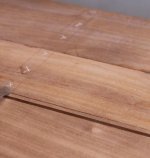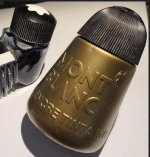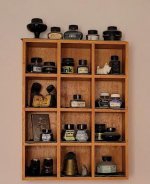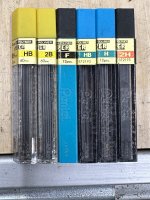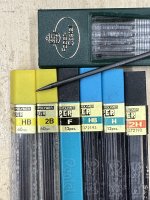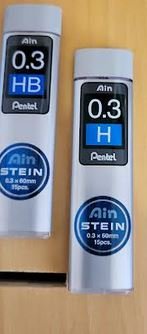Indeed, no pencils or pens can produce lines that can match lines scribed by a marking knife. For example, pencils or pens can't take the place of a knife if one wants to use this trick:https://www.finewoodworking.com/2016/09/29/scribe-tablesaws-throat-plate-quicker-crosscutsAlex said:I have become a great fan of the Pica pencil too and always have one around. But for real precision I use a marking knife.
You are using an out of date browser. It may not display this or other websites correctly.
You should upgrade or use an alternative browser.
You should upgrade or use an alternative browser.
Unbreakable Pencils
- Thread starter ChuckS
- Start date
Steve1 said:Snip.
Only time I now use my old mechanical pencils is when I have to say "where on earth did I put the green pencil?" It's bright green, so it normally turns up soon enough.
[attachimg=1]
The only time I use the pica is to make marks in white, including the cabinetmaker's triangles, on dark woods (walnut, sepele, etc.):
[attachimg=1]
Attachments
rvieceli said:these folks are a fun stop if you like writing stuff.
www.jetpens.com
Ron
[attachimg=1]
This is a rare one from Mont Blanc that my wife found for me in the late 70s. I used to use my Mont Blanc fountain pens daily.
[attachimg=2]
The bottled inks page reminds me of my collection on the wall.
Attachments
Mini Me
Member
ChuckS said:Indeed, no pencils or pens can produce lines that can match lines scribed by a marking knife. For example, pencils or pens can't take the place of a knife if one wants to use this trick:https://www.finewoodworking.com/2016/09/29/scribe-tablesaws-throat-plate-quicker-crosscuts
Chuck, sort of true but a hard leaded carpenter's pencil sharpened properly will equal any knife mark. The biggest advantage of a knife is it makes a mark that a chisel can be placed in and the same can be done with a hard lead if you press hard enough but the lead can break if too much pressure is applied and the knife does it way better. The disadvantage of this method is the pencil needs frequent maintenance to equal what the knife does, any hard leaded pencil sharpened with a flat face is equal to a knife in accuracy but not for as long.
Packard
Member
Just to be a pedant:
The subject should read: “Unbreakable Pencil Leads” or even more accurately “break resistant pencil leads”.
Given the opportunity, I am confident that I can break even the most robust pencils and their leads.
I misplaced one of my mechanical pencils a few months back. Later I found it on my driveway. Apparently, driving over a mechanical pencil is one way to break both the pencil and the leads. [big grin]
The subject should read: “Unbreakable Pencil Leads” or even more accurately “break resistant pencil leads”.
Given the opportunity, I am confident that I can break even the most robust pencils and their leads.
I misplaced one of my mechanical pencils a few months back. Later I found it on my driveway. Apparently, driving over a mechanical pencil is one way to break both the pencil and the leads. [big grin]
Cheese
Member
I assume everyone knows that the small Pentel pencil leads are available in different hardness levels so if you're having an issue with breakage, you could try a different hardness level to see if that helps.
Here are 2 each .9mm, 3 each .7mm and 1 each .5mm packs.
[attachimg=1]
For critical marking or to get right up to the edge I prefer to use a drafting pencil with a 2mm diameter lead. They sharpen up to a needle point and don't break easily. They do need to be sharpened constantly though because the point is so small.
[attachimg=2]
Here are 2 each .9mm, 3 each .7mm and 1 each .5mm packs.
[attachimg=1]
For critical marking or to get right up to the edge I prefer to use a drafting pencil with a 2mm diameter lead. They sharpen up to a needle point and don't break easily. They do need to be sharpened constantly though because the point is so small.
[attachimg=2]
Attachments
Michael Kellough
Member
Did a quick test with the Orenz .2mm pencil. Like other very small mechanical pencils the finest line is obtained when the pencil is held vertical, square to the surface. The supplied lead is pretty soft so if you lean the pencil over the lead wears quickly and the line gets wider.
That said I am surprised how far you can lean the pencil before the sleeve prevents the lead from touching the surface. About 45*. At that point the line is about .9mm wide and just good for shading a drawing. Remarkably the sleeves still prevents the tiny lead from breaking. Can’t do that with an ordinary .3mm pencil.
The sleeve is just a hair more than .6mm diameter so the center of the line made when following a rule is offset .3mm. However, using the pencil to match an existing line is easier done than described, unless the rule is tall and requires the pencil to lean away from the rule.
I think I would like this pencil a lot if loaded with a harder lead but I wonder is soft lead is needed to reduce breakage?
Maybe later I’ll have time to compare this to an ordinary .3mm pencil, both of which need to be used upright. The point is they can’t be used the way Cheese describes using thick drafting pencils. You need .5mm (or thicker) lead to get a durable enough point on the lead to get right up to the side of a rule, and you need to continuously rotate the barrel of the pencil to maintain a conical point.
That said I am surprised how far you can lean the pencil before the sleeve prevents the lead from touching the surface. About 45*. At that point the line is about .9mm wide and just good for shading a drawing. Remarkably the sleeves still prevents the tiny lead from breaking. Can’t do that with an ordinary .3mm pencil.
The sleeve is just a hair more than .6mm diameter so the center of the line made when following a rule is offset .3mm. However, using the pencil to match an existing line is easier done than described, unless the rule is tall and requires the pencil to lean away from the rule.
I think I would like this pencil a lot if loaded with a harder lead but I wonder is soft lead is needed to reduce breakage?
Maybe later I’ll have time to compare this to an ordinary .3mm pencil, both of which need to be used upright. The point is they can’t be used the way Cheese describes using thick drafting pencils. You need .5mm (or thicker) lead to get a durable enough point on the lead to get right up to the side of a rule, and you need to continuously rotate the barrel of the pencil to maintain a conical point.
Michael Kellough
Member
Tried comparing the Orenz to two .3mm pencils but they all have different leads so I'll just post my observations.
My favorite is the Pentel Graphgear 1000 .3mm pencil.
It's a robust construction with a comfortable grip and a long nose that's easy to see around.
The pocket clip is a lever that also withdraws the pointy nose leaving a nice blunt end for inserting into your shirt pocket.
The eraser cap has a raised rim so it's easy to grip to pull off to get to the eraser.
The lead sleeve is rigid so it provides good protection for the lead. The sleeve is about 1mm in diameter and about 5mm long so it can get into tight spaces for marking.
Lead advances in tiny increment so you can keep the lead projection at the ideal length, about 1/2mm.
Ten clicks of the advance mechanism moves the lead out just .125" and the projected lead can be pushed back in when the advance plunger is held down.
The KOH-I-NOR Rapidomatic .3mm pencil is much more traditional drafting style pencil.
Like a drafting pencil it has a rotating sleeve so you can indicate which grade of lead is installed.
It gets the job done but it's by far second best.
The nose is shorter than the Graphgear, the knurled metal grip is secure but uncomfortable after a while.
Ten clicks of the lead advance moves the lead out .1875", pretty fine but you have to be a little more careful than with the Graphgear.
Also, once the lead is out too far it can only be pushed back in with extreme care. The advance lead grippers are tight.
The pocket clip is just that. The 1mm lead sleeve is permanently out about 5mm and the eraser sleeve is slippery.
That said, I have H lead installed and it makes a very fine line. And it can be rotated to keep the lead point conical and make a line much finer than its rated size, as long as the projection is less than 1mm. The Graphgear can also be rotated but the smaller diameter of this knurled body is easier to rotate.
By comparison the Pentel ORENZ feels like a disposable instrument. The body is just a lightweight hollow plastic tube.
Mine is white plastic which allows light to pass through making it easy to see how much lead is inside. It came with three sticks.
The grip is slippery, it could really use a rubbery sleeve. The eraser cover is also slippery.
The lead advances a little faster than the Graphgear but since the sleeve follows the lead it's perfectly fine.
The big idea with this pencil is that the sleeve fully protects the lead. The lead is only supposed to be advanced to the end of the sleeve.
As the lead is worn down the sleeve backs into the housing and to keep drawing you just give it one click occasionally without even needing to look.
This is pencil would be really good for something like writing a very long letter on a small piece of paper, or a very intricate drawing.
I think the lead it ships with is too soft for the finest marks but if you could buy five of them for $20 and load them with H lead they would be good to leave all around the shop.
Until then the Graphgear will be the pencil in my pocket. The Rapidomatic stays in the desk drawer.
My favorite is the Pentel Graphgear 1000 .3mm pencil.
It's a robust construction with a comfortable grip and a long nose that's easy to see around.
The pocket clip is a lever that also withdraws the pointy nose leaving a nice blunt end for inserting into your shirt pocket.
The eraser cap has a raised rim so it's easy to grip to pull off to get to the eraser.
The lead sleeve is rigid so it provides good protection for the lead. The sleeve is about 1mm in diameter and about 5mm long so it can get into tight spaces for marking.
Lead advances in tiny increment so you can keep the lead projection at the ideal length, about 1/2mm.
Ten clicks of the advance mechanism moves the lead out just .125" and the projected lead can be pushed back in when the advance plunger is held down.
The KOH-I-NOR Rapidomatic .3mm pencil is much more traditional drafting style pencil.
Like a drafting pencil it has a rotating sleeve so you can indicate which grade of lead is installed.
It gets the job done but it's by far second best.
The nose is shorter than the Graphgear, the knurled metal grip is secure but uncomfortable after a while.
Ten clicks of the lead advance moves the lead out .1875", pretty fine but you have to be a little more careful than with the Graphgear.
Also, once the lead is out too far it can only be pushed back in with extreme care. The advance lead grippers are tight.
The pocket clip is just that. The 1mm lead sleeve is permanently out about 5mm and the eraser sleeve is slippery.
That said, I have H lead installed and it makes a very fine line. And it can be rotated to keep the lead point conical and make a line much finer than its rated size, as long as the projection is less than 1mm. The Graphgear can also be rotated but the smaller diameter of this knurled body is easier to rotate.
By comparison the Pentel ORENZ feels like a disposable instrument. The body is just a lightweight hollow plastic tube.
Mine is white plastic which allows light to pass through making it easy to see how much lead is inside. It came with three sticks.
The grip is slippery, it could really use a rubbery sleeve. The eraser cover is also slippery.
The lead advances a little faster than the Graphgear but since the sleeve follows the lead it's perfectly fine.
The big idea with this pencil is that the sleeve fully protects the lead. The lead is only supposed to be advanced to the end of the sleeve.
As the lead is worn down the sleeve backs into the housing and to keep drawing you just give it one click occasionally without even needing to look.
This is pencil would be really good for something like writing a very long letter on a small piece of paper, or a very intricate drawing.
I think the lead it ships with is too soft for the finest marks but if you could buy five of them for $20 and load them with H lead they would be good to leave all around the shop.
Until then the Graphgear will be the pencil in my pocket. The Rapidomatic stays in the desk drawer.
Michael Kellough
Member
Checked the shop and discovered a Zebra Del Guard .3mm pencil.
I’d put it just below the Graphgear if the tip wasn’t so blunt. Also, mine is the cheaper lightweight plastic version and the wavy plastic grip is slippery. But I have dry skin so everything is slippery to me.
The lead advancement is just as fine as the Graphgear but the spring loaded mechanism that is supposed to reduce breakage is too stiff for .3 lead. Maybe it works with stronger lead…
I’d put it just below the Graphgear if the tip wasn’t so blunt. Also, mine is the cheaper lightweight plastic version and the wavy plastic grip is slippery. But I have dry skin so everything is slippery to me.
The lead advancement is just as fine as the Graphgear but the spring loaded mechanism that is supposed to reduce breakage is too stiff for .3 lead. Maybe it works with stronger lead…
Cheese
Member
Michael Kellough said:The point is they can’t be used the way Cheese describes using thick drafting pencils.
You need .5mm (or thicker) lead to get a durable enough point on the lead to get right up to the side of a rule, and you need to continuously rotate the barrel of the pencil to maintain a conical point.
And the dinner winner award for the evening goes to Michael K... [not worthy] [not worthy] ...while that seems to be a PITA (and it is) that's the real deal. If you continue to rotate the pencil you'll get improved life from the sharpened tip.
It was just something that became second nature before computers were invented.
Similar threads
- Replies
- 0
- Views
- 364
- Replies
- 12
- Views
- 1K

